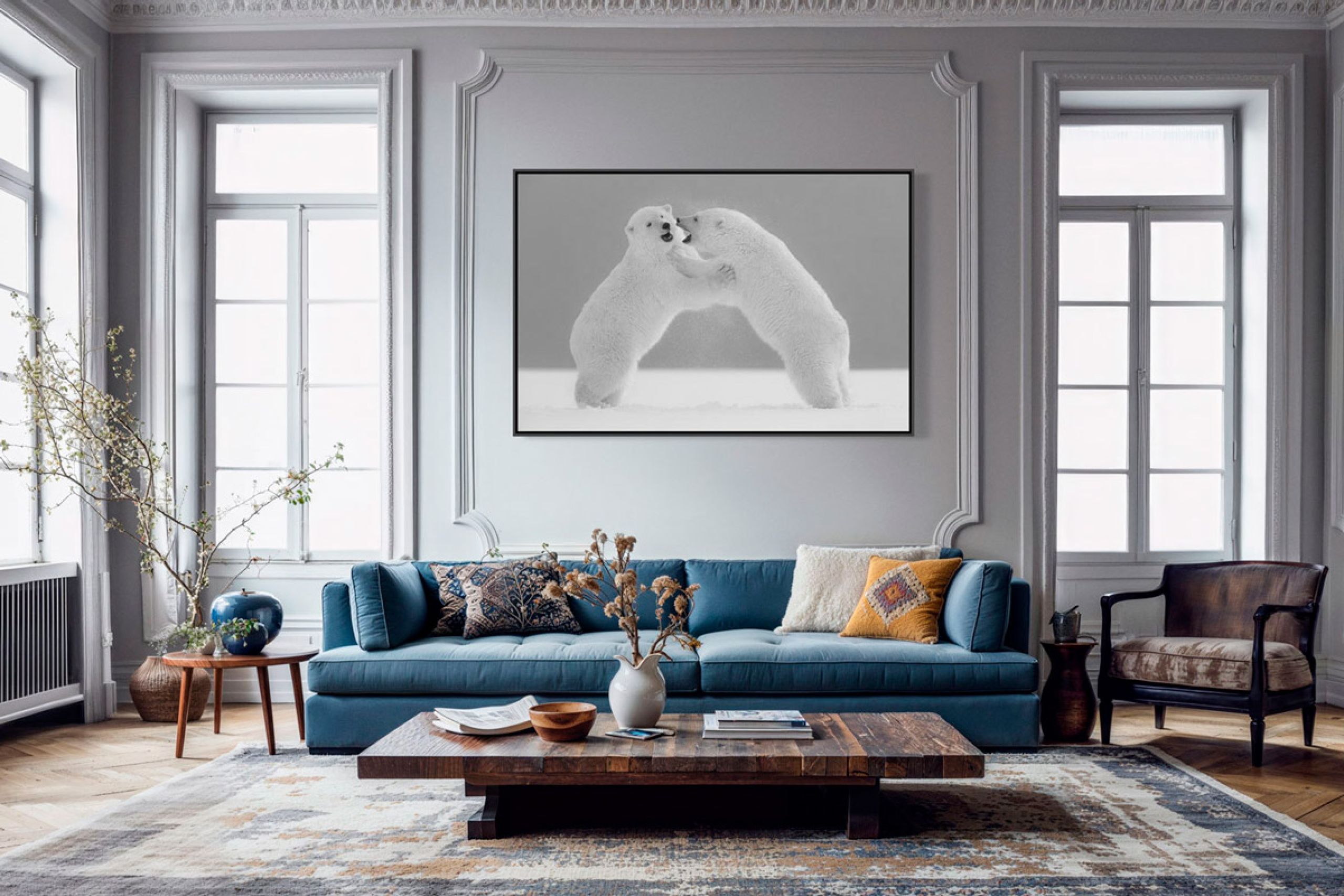The impact of a photographic artwork in your home, atmosphere, acoustics, light

A fine art photograph does not just “fill” a wall, it transforms the atmosphere of a room, it influences your mood, it interacts with the light of the space. To choose it well for your living room, hallway or bedroom, you need to understand how an image behaves in space, not just on a screen. This guide offers practical advice and real examples to help you go from a vague crush to an artwork that truly works in your home, day after day.
Atmosphere, what the image makes you feel
Start by viewing your room like a stage. If your living room is warm, wood, rugs, soft lighting, a photograph with warm tones will extend that cozy feeling, with sunsets, golden textures, skin tones, amber hues. In a bright minimalist room, a black and white image with a strong graphic design will add structure and presence without overwhelming. Conversely, if your dining room lacks energy, a travel photograph with bold colors can act as visual vitamins and become the conversation piece around the table.
The lines in the image also affect how the space feels. A horizontal photograph stretches the wall, it “opens” the scene, ideal above a sofa. A vertical image adds height to a low-ceilinged space, perfect between two windows or at the end of a hallway. Perspectives that lead outward give depth, while more centered compositions create a bubble, an intimate space.
Light, your best ally
A work of art is read through light more than through pixels. Avoid direct sunlight which can fade colors and create glare. If your wall gets a lot of light, choose a print on matte paper with anti-reflective glass. If the room has soft lighting, curtains, and controlled ambiance, baryta or semi-gloss paper will enhance blacks and fine textures.
A little accent lighting changes everything. A discreet spotlight angled at around 30° from the ceiling will light the image without glare. For atmosphere, choose warm bulbs around 2700-3000 K for living rooms and bedrooms. For reading corners, increase slightly to 3000-3500 K for more accurate color rendering. If in doubt, turn off all other lights and leave only a soft one on the artwork. Let your eyes decide, does the image breathe, does it speak to you?
Size and proportions, a question of balance
The right format comes from looking at the space around it. Above a 2-meter wide sofa, a photograph about 120 to 150 cm wide will create a natural balance, neither shy nor overwhelming. If you’re unsure, tape the width on the wall and live with this “ghost” for 24 hours. You’ll quickly feel whether it’s too small or too large.
Height matters as much as width. Hang the image so that its center is around 145 cm from the floor, which is the most comfortable viewing height whether seated or standing. In a stairway, follow the incline with a slightly rising horizon line to help the eye glide naturally.
If the space needs rhythm, think diptych or triptych. Three aligned images, same palette, same horizon, give life to a large wall without overpowering it. In contrast, in a small hallway, one clear and readable image will be more effective than a crowded patchwork.
Materials and framing, aesthetic and visual comfort
A floating frame brings discreet elegance, creating a fine shadow line that enhances the photo. The floating frame works well for large formats, it “lightens” the visual weight and lets the image speak. An off-white mat board softens, pure white energizes. When it comes to glazing, anti-reflective and UV-protective options are not luxuries, they are essential for both viewing comfort and longevity, especially if the piece is exposed to strong light or faces a large window.
Acoustics, the unexpected bonus
Several artworks along a hallway break floating echoes by interrupting blank surfaces. In a slightly echoing living room, combine the photograph with textiles, rugs, curtains, cushions, and open furniture like a bookshelf.
Why some artworks “work” better than others at home
It all comes down to viewing distance and visual complexity. A highly detailed image, dense forest, crowd, intricate textures, needs room to breathe. It will be stunning in a large living room or at the top of a staircase where you can step back. A graphic composition, with horizon lines, architecture, black and white, reads perfectly from close up, ideal for a hallway or small office corner.
Then comes the choice between harmony and contrast. If your interior is soft and neutral, linen tones, light oak, a photograph in similar hues will extend that calm feeling. If you want a focal point, embrace contrast, like a deep midnight blue on a white wall, or a strong black and white in a beige room. The artwork becomes the voice of the room.
Room by room examples
Living room. This is the stage of the home. A large image above the sofa sets the tone. If the room is welcoming, favor open subjects, bright landscapes, horizons, travel scenes. If it’s very minimalist, a strong black and white will add character. Simple test, sit in your favorite spot, imagine the artwork at scale, ask yourself if you could look at it for an hour at the end of the day without visual fatigue.
Dining room, kitchen. This is where people gather, talk, laugh. A warm image, with spicy colors, street scenes, delicious textures, supports the conviviality without stealing the spotlight. Avoid images that are too dark if the space already lacks light.
Bedroom. Seek calm. Soft tones, peaceful horizons, morning light. Place the artwork where you will see it when waking up. Ask yourself what emotion you want to start the day with, softness, energy, reverie.
Entrance and hallway. This is a passage zone. The artwork should be readable in one glance. Favor clear compositions, verticals to add height, panoramas to widen. An entryway is a “prologue,” the image announces the spirit of the home.
The ultimate criterion, emotion
Rules help, but emotion decides. Between two technically suitable images, keep the one that moves you, calm, intensity, curiosity, poetry. Come back to it in the morning, at night, with or without lighting. If each time you want to rest your eyes on it, that’s the one.
If you’re giving a photograph as a gift and the choice feels tricky, even if you know the person well, offer a Une image pour rêver gift card. It allows the recipient to choose the artwork that brings the strongest positive emotion while honoring your intention of a personal, lasting gift. We can suggest a curated pre-selection based on their taste, and let their emotion make the final decision.
Find the image that reflects you
Send us a photo of your wall, its dimensions, the wall color, and the room’s light. We will suggest an informed selection, subject, size, paper, framing, placement and, if you wish, provide visual simulations to help you see, before hanging, how the artwork will transform your space. Because a well-chosen photograph does not just decorate your home, it inhabits it, and it inhabits you.



